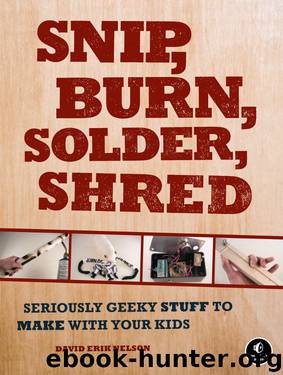Snip, Burn, Solder, Shred by David Erik Nelson

Author:David Erik Nelson [Nelson, David Erik]
Language: eng
Format: epub
Tags: CRA043000 Crafts & Hobbies / Crafts For Children
ISBN: 9781593272593
Publisher: No Starch Press
Published: 2015-02-02T16:00:00+00:00
FIGURE 14-8: The Spring Reverb’s electronic guts thus far
Step 9 Now it’s time to test the unit. Turn both pots fully counterclockwise, plug an audio source (such as an old CD player) into the input, plug an amplifier (such as the Dirt-Cheap Amp from Project 12) into the output, add a battery to the Spring Reverb, and flip the power switch. If the Spring Reverb is self-oscillating (i.e., howling like a heart-broken dog) or picking up local AM radio, then try connecting a 4.7–47 μF capacitor from pin 7 of the LM386 IC to the ground (the leg of the capacitor marked with the thick stripe connects to the ground). Otherwise, turn on your audio source. Slowly turn the D pot clockwise; the audio signal from your radio (or whatever) should come out of the amp basically unchanged—this is called the dry signal. Turn the D pot all the way down (counterclockwise), and then slowly turn the W pot up; now you should hear your radio tinnily playing through the exciter piezo element. Gently nudge the other piezo element (the recovery pickup piezo); the amp should scrape and thunk loudly. Turn off the audio source and amp, turn both pots fully counterclockwise, and nudge the recovery pickup piezo again. If you hear scraping coming from the exciter piezo, then there is feedback within the circuit. Try rewiring the ground to isolate the W and D pots (i.e., have the ground go back to the battery between the two). Failing all else, add a 1k resistor (brown-black-red) between the hot and ground lugs on the output, or interrupt the ground with a 1k resistor connected in series, especially on the recovery pickup’s ground connection.
Once any intra-circuit feedback issues are resolved, switch the amp and audio source back on, turn the W pot fully clockwise, and hang the spring between the piezo elements, hammock style; you’ll hear a sproingy, tinny version of the music. Experiment with stretching the elements apart to put some tension in the spring; now you should hear the music clearly (there won’t be much bass) with lots of metallic echoes, like a radio playing inside a sealed 50-gallon steel drum at the bottom of a lifeless sea. This is the wet signal. Experiment with different amounts of tension until you find the one you like best, and measure the distance between the two piezo elements, as shown in Figure 14-9.
Download
This site does not store any files on its server. We only index and link to content provided by other sites. Please contact the content providers to delete copyright contents if any and email us, we'll remove relevant links or contents immediately.
| Dollhouses | Dolls & Doll Clothing |
| Miniatures | Model Trains |
| Models | Stuffed Animals |
| Toymaking | Wood Toys |
On Writing A Memoir of the Craft by Stephen King(4893)
The Doodle Revolution by Sunni Brown(4717)
A Simplified Life by Emily Ley(4134)
Mummy Knew by Lisa James(3658)
Marijuana Grower's Handbook by Ed Rosenthal(3648)
Better Homes and Gardens New Cookbook by Better Homes & Gardens(3550)
Figure Drawing for Artists by Steve Huston(3412)
Paper Parties by Erin Hung(3399)
Draw Your Day by Samantha Dion Baker(3322)
The Genius of Japanese Carpentry by Azby Brown(3256)
The Code Book by Simon Singh(3142)
Japanese Design by Patricia J. Graham(3139)
Dangerous Girls by Haas Abigail(3000)
Lions and Lace by Meagan Mckinney(2942)
The Curated Closet by Anuschka Rees(2941)
How to Make Your Own Soap by Sally Hornsey(2869)
The Checklist Manifesto by Atul Gawande(2814)
Zero to Make by David Lang(2757)
The Wardrobe Wakeup by Lois Joy Johnson(2756)
